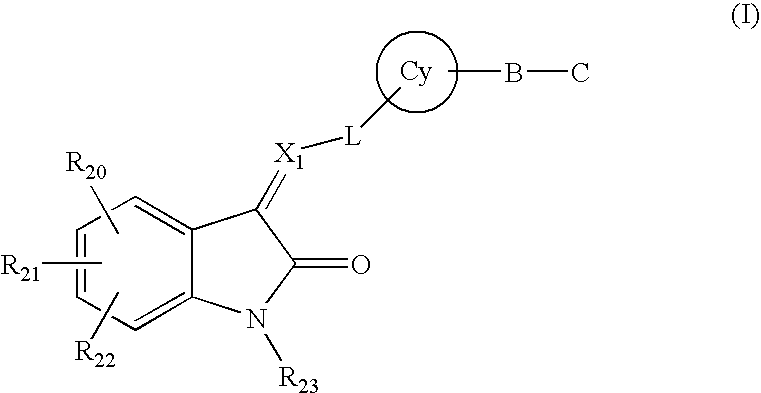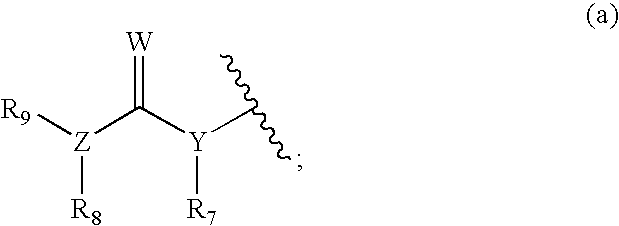Substituted 2-indolinone as PTK inhibitors containing a zinc binding moiety
a technology of zinc binding moiety and substituted 2indolinone, which is applied in the direction of drug composition, immunodeficiency, metabolism disorder, etc., can solve the problems of limited ability to use such combinations, limited treatment regimes using cytotoxic cocktail drugs, and high concentration of cytotoxic cocktail drugs, etc., to achieve enhanced activity, inhibit hdac, and effective treatment
- Summary
- Abstract
- Description
- Claims
- Application Information
AI Technical Summary
Benefits of technology
Problems solved by technology
Method used
Image
Examples
example 1
Preparation of 5-((Z)-(5-fluoro-2-oxoindolin-3-ylidene)methyl)-N-hydroxy-2,4-dimethyl-1H-pyrrole-3-carboxamide (compound 1)
Step 1a. 5-fluoroindolin-2-one (compound 102)
[0194]KOH (4.07 g, 73 mmol) was added into a mixture of compound 101 (6.0 g, 36 mmol), ethyleneglycol (95 mL) and hydrazine hydrate (2.6 g, 52 mmol). The reaction mixture was stirred at 80° C. for 3 h, and then was cooled to room temperature and was poured to ice cold water. The pH of the above mixture was adjusted to pH 1-2 with 12 N hydrochloric acid and the mixture was stirred at room temperature for 12 h. The mixture was then extracted with EtOAc. The organic phase was collected, evaporated to give yellow solid product 102 (4.5 g. 81.9%). LCMS: m / z 152(M+1), 1HNMR (DMSO-d6) δ3.46 (s, 2H), 6.95 (m, 3H), 10.35 (s, 1H).
Step 1b. tert-Butyl 2-(hydroxyimino)-3-oxobutanoate (compound 104)
[0195]To a solution of compound 103 (69.52 g, 44 mol) in glacial acetic acid (500 mL) cooled to 5° C. was added dropwise a cold solutio...
example 2
Preparation of N-(2-(hydroxycarbamoyl)ethyl)-5-((Z)-(5-fluoro-2-oxoindolin-3-ylidene)methyl)-2,4-dimethyl-1H-pyrrole-3-carboxamide (compound 2)
Step 2a. Methyl 3-(5-((Z)-(5-fluoro-2-oxoindolin-3-ylidene)methyl)-2,4-dimethyl-1H-pyrrole-3-carboxamido)propanoate (compound 110-2)
[0201]To a stirred solution of 1 (0.5 g, 1.67 mmol) in DMF (35 mL) at room temperature was added HOBt (1.02 g, 7.52 mmol), triethylamine (2.12 mL, 15.03 mmol), ECDI.HCl (1.44 g, 1.52 mmol) and methyl 3-aminopropanate hydrochloride (0.7 g, 5.0 mmol) successively. The mixture was stirred for 24 h at room temperature and then was diluted with water (20 mL), brine (20 mL) and saturated bicarbonate solution (20 mL) and the pH of solution was adjusted to 11˜12 with 10 mol / L NaOH. The mixture was filtrated and the solid was collected washed with water, dried to obtain crude yellow solid product 110-2 (0.44 g, 68.3%). LCMS: m / z 386(M+1), 1H NMR (DMSO-d6) δ2.38 (s, 3H), 2.41 (s, 3H), 2.50 (t, 2H), 3.44 (t, 2H), 3.62 (s, 3...
example 3
Preparation of N-(3-(hydroxycarbamoyl)propyl)-5-((Z)-(5-fluoro-2-oxoindolin-3-ylidene)methyl)-2,4-dimethyl-1H-pyrrole-3-carboxamide (compound 3)
Step 3a. Methyl 4-(5-((Z)-(5-fluoro-2-oxoindolin-3-ylidene)methyl)-2,4-dimethyl-1H-pyrrole-3-carboxamido)butanoate (Compound 110-3)
[0203]To a stirred solution of compound 1 (0.5 g, 1.67 mmol) in DMF (35 mL) at room temperature was added HOBt (1.02 g, 7.52 mmol), triethylamine (2.12 mL, 15.03 mmol), ECDI.HCl (1.44 g, 1.52 mmol) and methyl 4-aminobutanate hydrochloride (0.77 g, 5.0 mmol) successively. The mixture was stirred for 24 h at room temperature and then was diluted with water (20 mL), brine (20 mL) and saturated bicarbonate solution (20 mL) and the pH of solution was adjusted to 11˜12 with 10 mol / L NaOH. The mixture was filtrated, the solid was collected, washed with water and dried to obtain crude yellow solid product 110-3 (0.32 g, 48.3%). LCMS: m / z 400(M+1), 1H NMR (DMSO-d6) δ1.77 (m, 2H), 2.39 (m, 4H), 2.42 (s, 3H), 2.49 (s, 3H), ...
PUM
| Property | Measurement | Unit |
|---|---|---|
| body weight | aaaaa | aaaaa |
| body weight | aaaaa | aaaaa |
| temperature | aaaaa | aaaaa |
Abstract
Description
Claims
Application Information
 Login to View More
Login to View More - R&D
- Intellectual Property
- Life Sciences
- Materials
- Tech Scout
- Unparalleled Data Quality
- Higher Quality Content
- 60% Fewer Hallucinations
Browse by: Latest US Patents, China's latest patents, Technical Efficacy Thesaurus, Application Domain, Technology Topic, Popular Technical Reports.
© 2025 PatSnap. All rights reserved.Legal|Privacy policy|Modern Slavery Act Transparency Statement|Sitemap|About US| Contact US: help@patsnap.com



